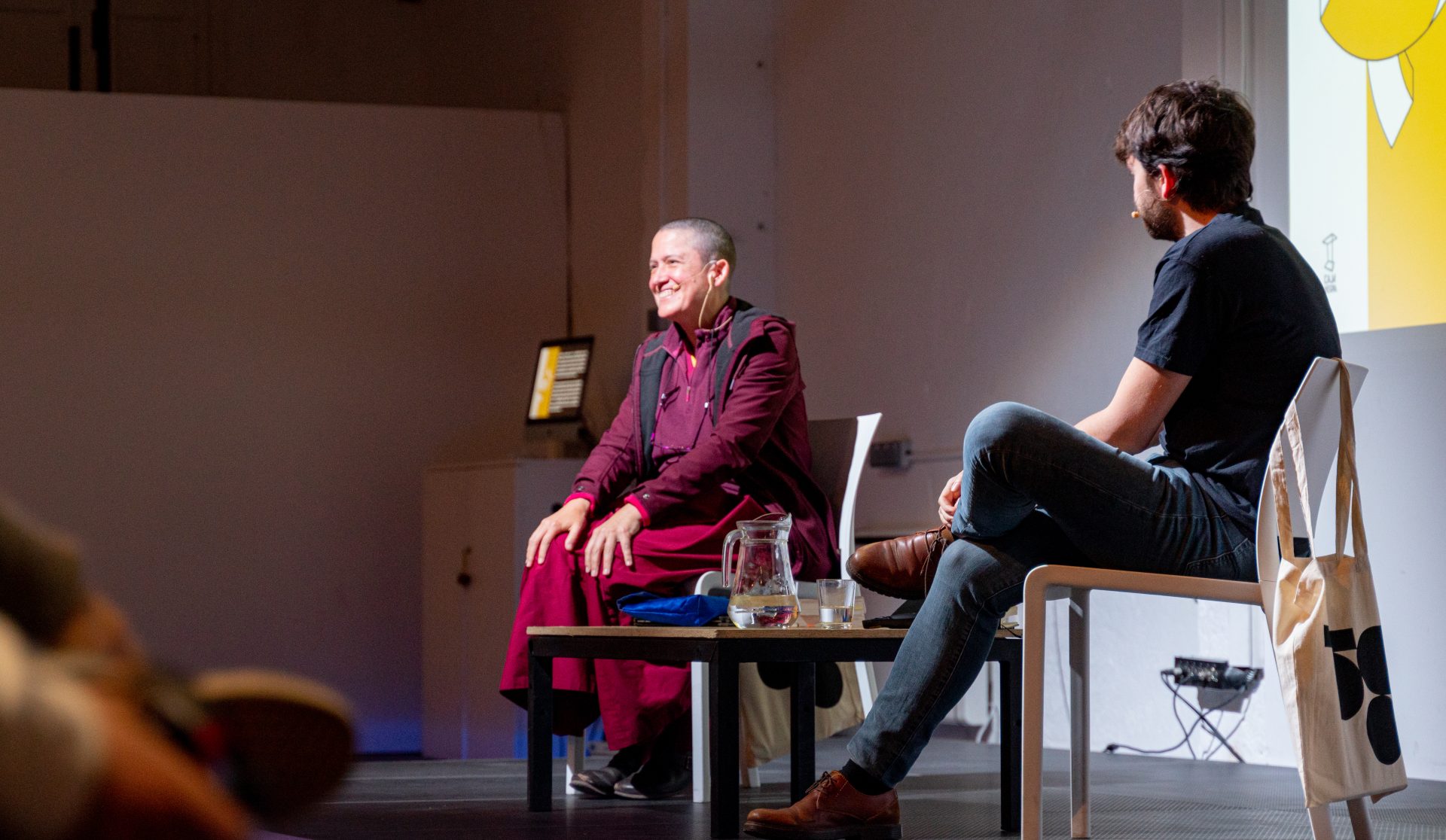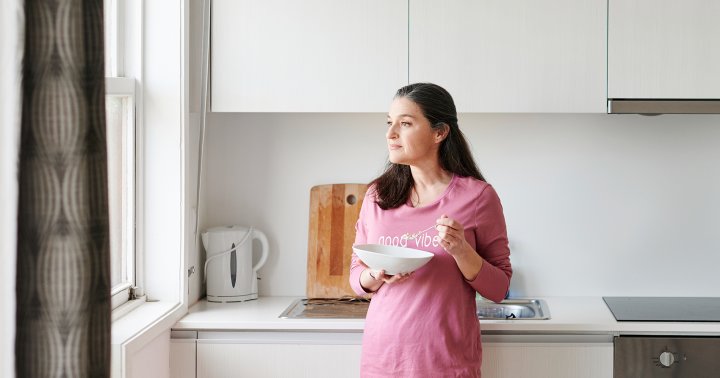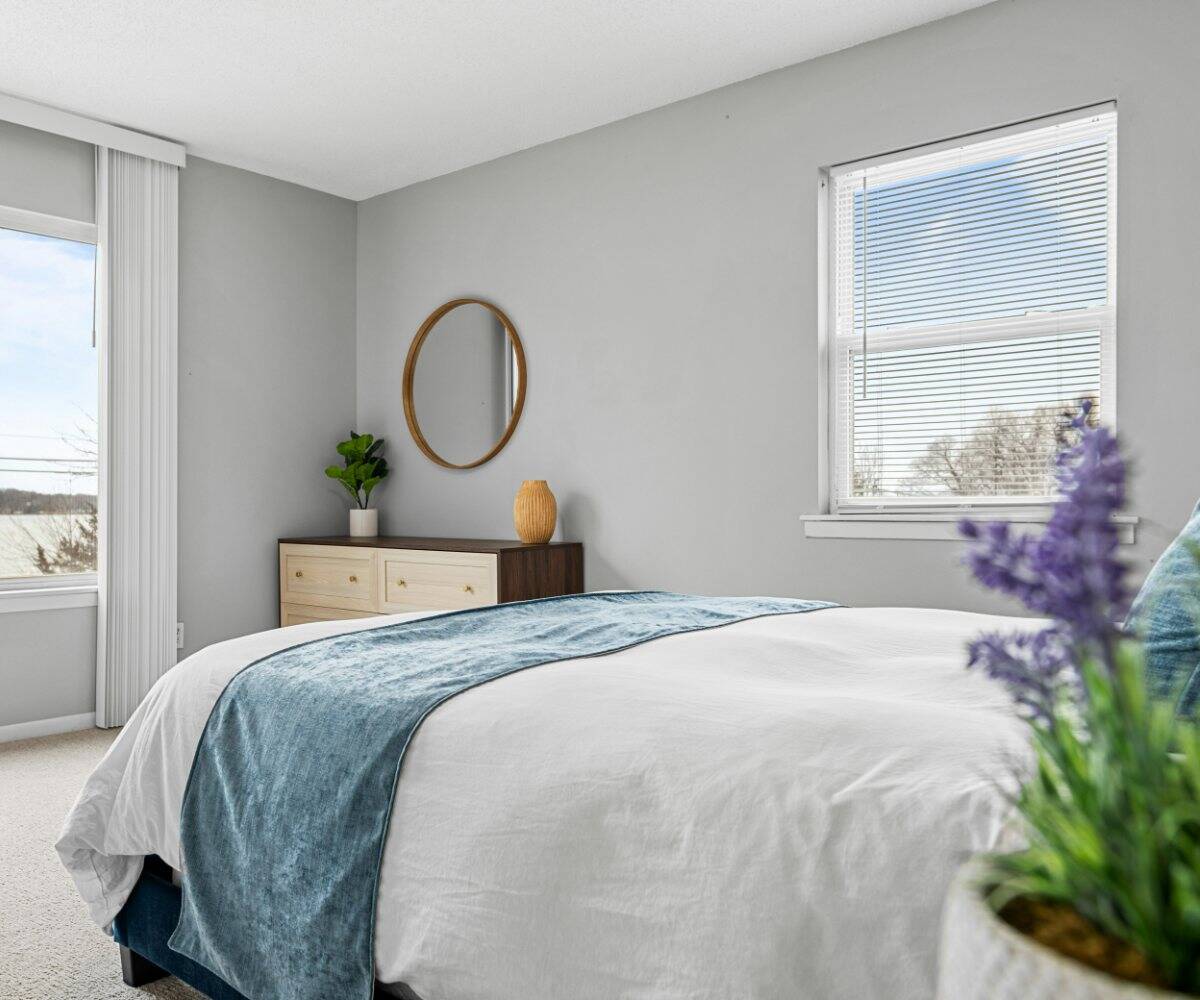Yoga Poses For Beginners: 20 Simple & Easy Yoga Poses Anyone Can Do
The post Yoga Poses For Beginners: 20 Simple & Easy Yoga Poses Anyone Can Do appeared first on The Yoga Nomads.
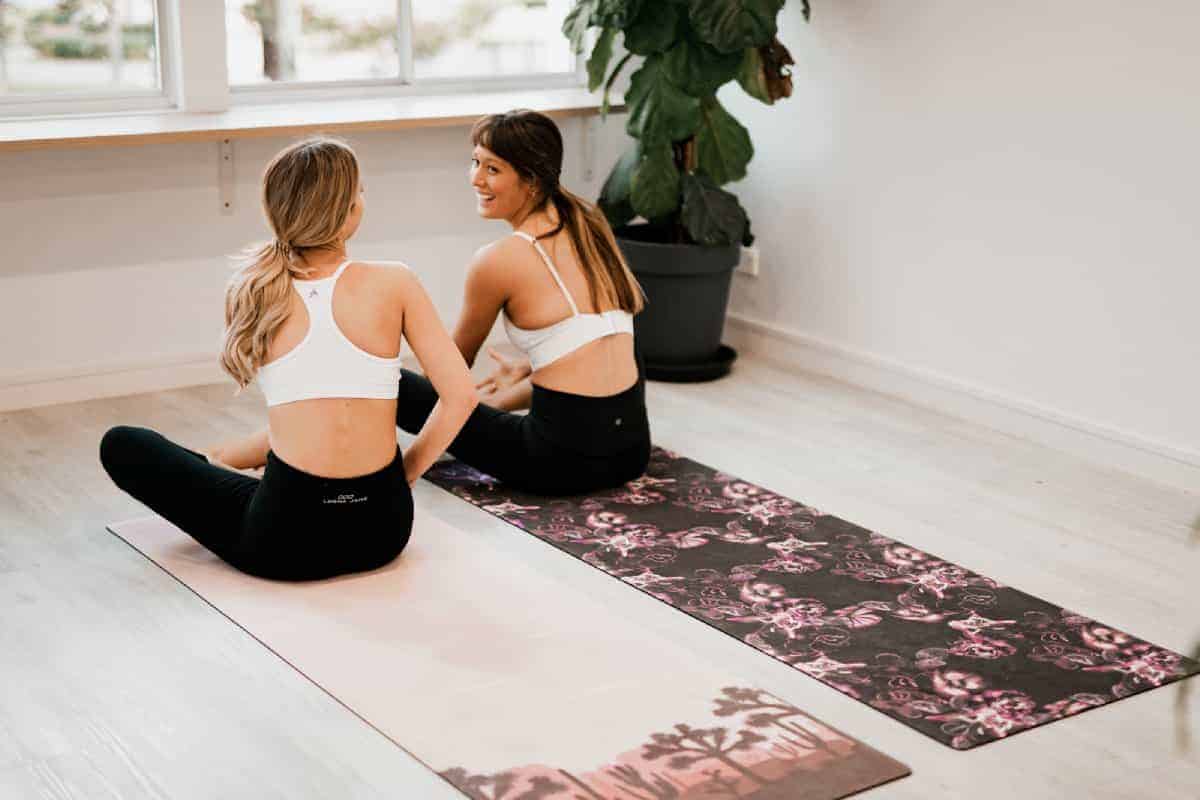
You don’t have to scroll through Instagram for long before you come across a super bendy yogi in a handstand, tight bind, or arm balance.
I get it: seeing ultra-flexible people in these advanced poses can be super off-putting if you’re new to yoga.
This is why, as a yoga teacher who truly believes yoga is for EVERY body, I’m passionate about showing newbies just how accessible the practice is.
Forget what you’ve seen on social media or in the studio. There are many easy yoga poses for beginners, regardless of how inflexible you are.
From downward-facing dog to warrior 2, here are 20 basic poses you can enjoy straight away.
Standing Yoga Poses for beginners
Let’s begin with the most basic yoga poses in the standing category. Standing poses are excellent for strengthening the legs, improving posture and balance, and increasing energy levels. You can do these poses individually or link them together in a flow, as is done in Vinyasa yoga.
Mountain Pose
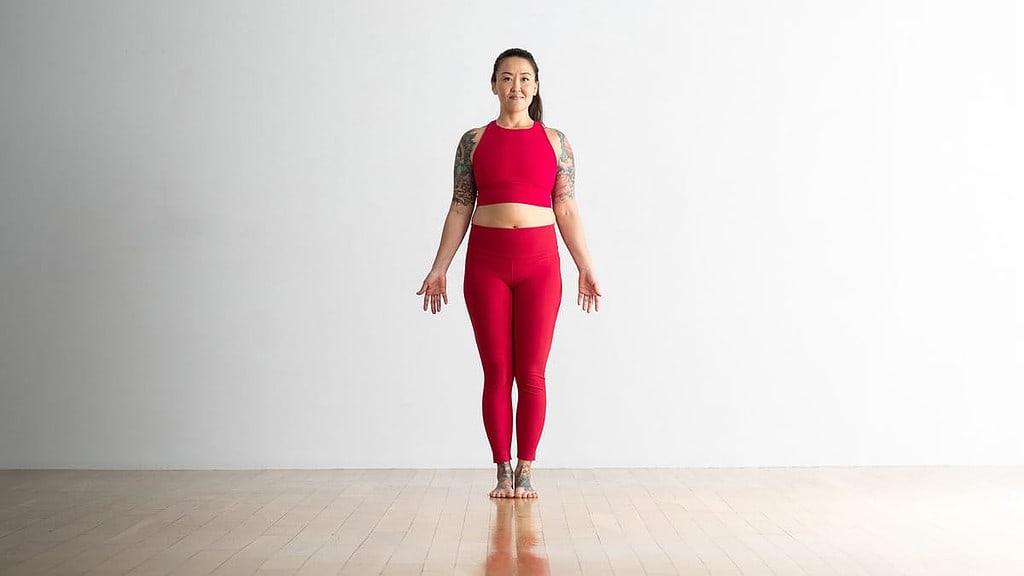
Mountain pose, known as Tadasana in Sanskrit, is one of the most underrated yoga poses for beginners. While it looks straightforward, a lot is going on here. Mountain pose is not just standing upright. It requires the engagement of many muscles as well as bandhas.
Mountain pose,
Improves posture Strengthens the back, hips, and legs Tones the core Boosts blood circulation.Here’s how to do it:
Traditionally you stand with the feet together. But as a beginner, it’s OK to have the feet hip-width apart. Choose what feels best for you. Bring your awareness to the feet and press into the four corners of each foot, so you spread the weight evenly. With straight legs, energetically lift the kneecaps to engage the thigh muscles. Draw your belly button in to engage the core. Relax your shoulders away from your ears with your arms extended by your sides, palms facing forwards. Imagine you have a string attached to the crown of your head, pulling you up to the universe. Feel your neck and spine elongate but keep your feet and lower body firmly grounded to the earth.Warrior I
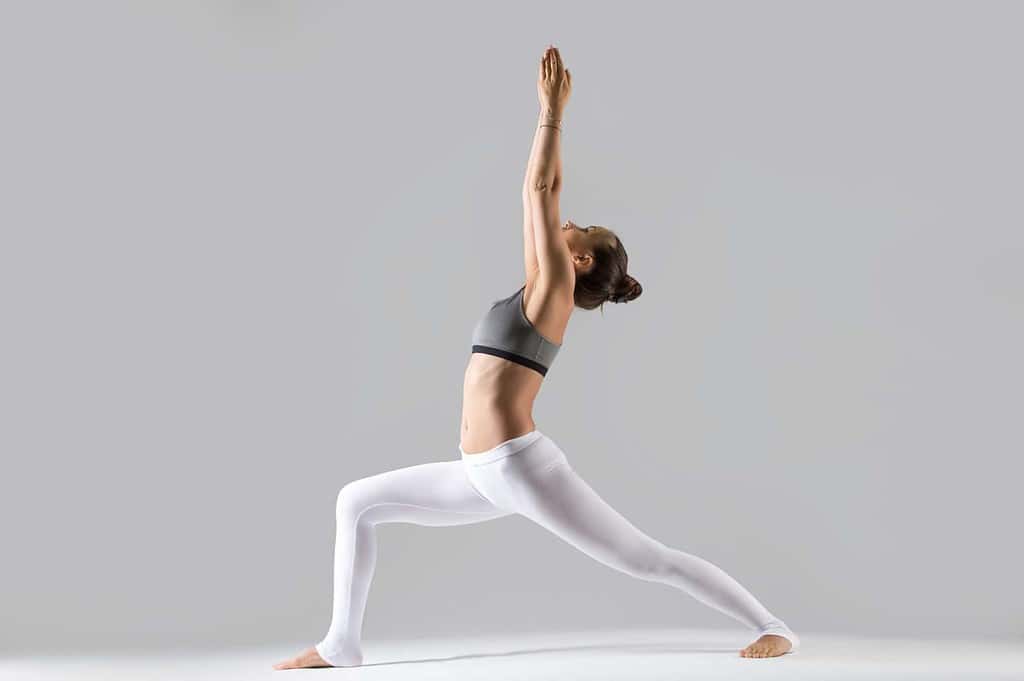
Warrior 1 is the first of the three warrior poses. With the front knee bent and the arms raised, it works muscles in the entire body. The benefits include:
Energizes the body Strengthens the legs, arms, shoulders, and back Opens the hips, chest, and lungs Improves lung capacity and stabilityHere’s how to do it:
From the mountain pose, step your right foot back, turning the foot out to 45 degrees (the toes should point to the top right corner of your mat). Keep the toes of the left foot facing forwards. Keep your back leg straight as you bend into the front knee and sink the hips. Your knee should be stacked over the ankle. If you don’t feel a stretch in the hips, increase the distance between both legs. The most crucial alignment tip for warrior 1 is keeping the hips facing forward. So bring your hands to your hips and turn them to the front of that mat. If your hips are naturally opening to the side, increase the width between your feet. Keeping the left knee bent, extend your arms alongside your ears, pointing toward the ceiling. Keep a straight spine and look forwards.Warrior II
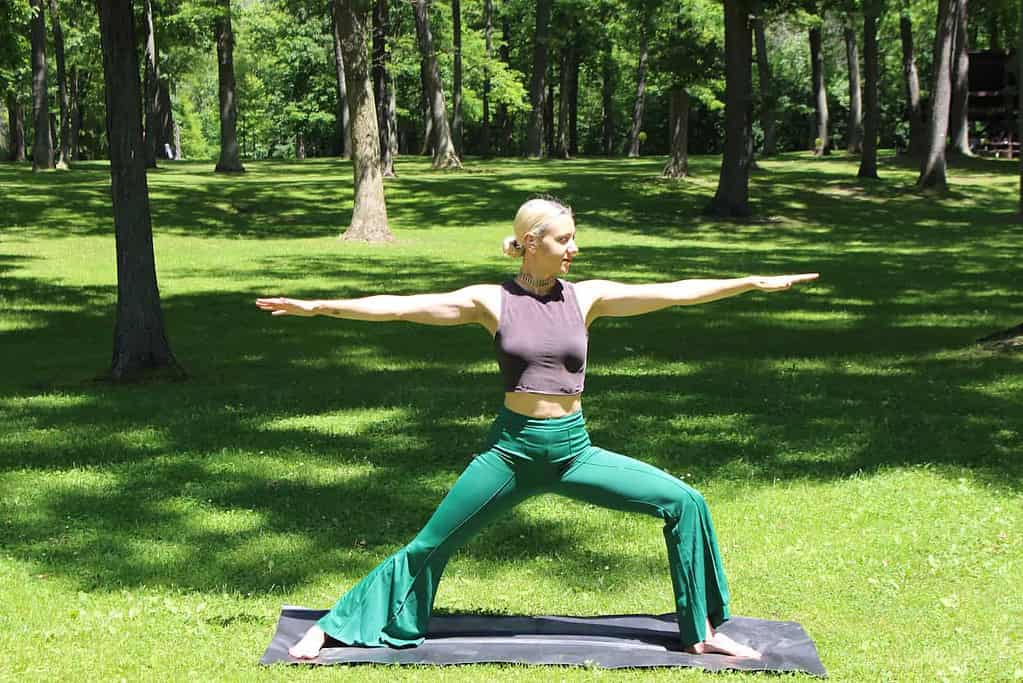
The main difference between warrior I and warrior II is that the hips are open in the latter posture. Warrior II has the same benefits as the previous pose, but it opens the chest more and gives a deeper groin stretch.
For the hips to open, the back foot needs to be turned to a 90-degree angle instead of a 45-degree one. So the back toes should point to the side of the mat rather than the corner. The front toes remain pointing forward. Like with warrior 1, bend your front knee until it stacks over the ankle. Keep the back leg straight. Check that the hips are open to the side. You can widen the distance between the feet to lower the hips and get a deeper stretch. Extend your arms to shoulder height, with one arm pointing at the front of the mat and the other towards the back. Palms should be face down. Check that your rear arm is level with the front one. Press evenly into both legs, engage the core, and look towards your front hand.Reverse Warrior
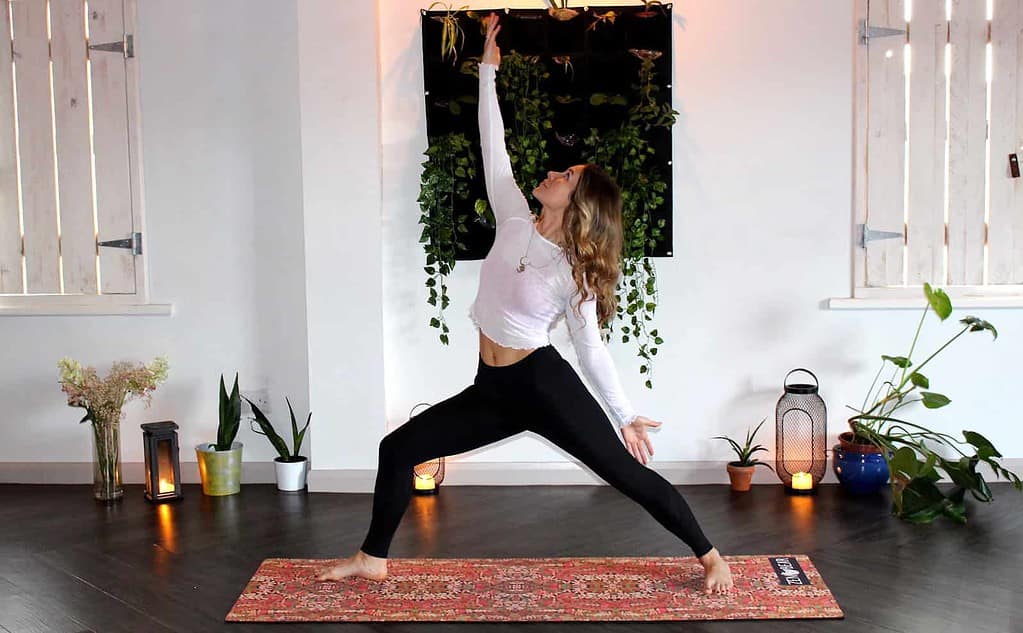
Reverse warrior is an excellent pose to do straight after warrior 2, as the leg position remains the same. Along with stretching and strengthening the hips and legs, this posture adds a deep side lateral stretch. As a result, reverse warrior:
Opens the chest and side body Releases tension in the intercostal muscles and promotes deeper breathing. Improves spinal mobility Brings a deeper stretch to the front quadFrom a warrior 2 position with the arms extended:
Flip your front palm and extend that arm forward. Inhale as you sweep your front arm up and back, bringing your backhand to your back thigh. Keep drawing your top hand up and back until you feel a good stretch in the front side body. Ensure your left knee stays bent and balance your body weight equally between both legs for stability.Triangle Pose
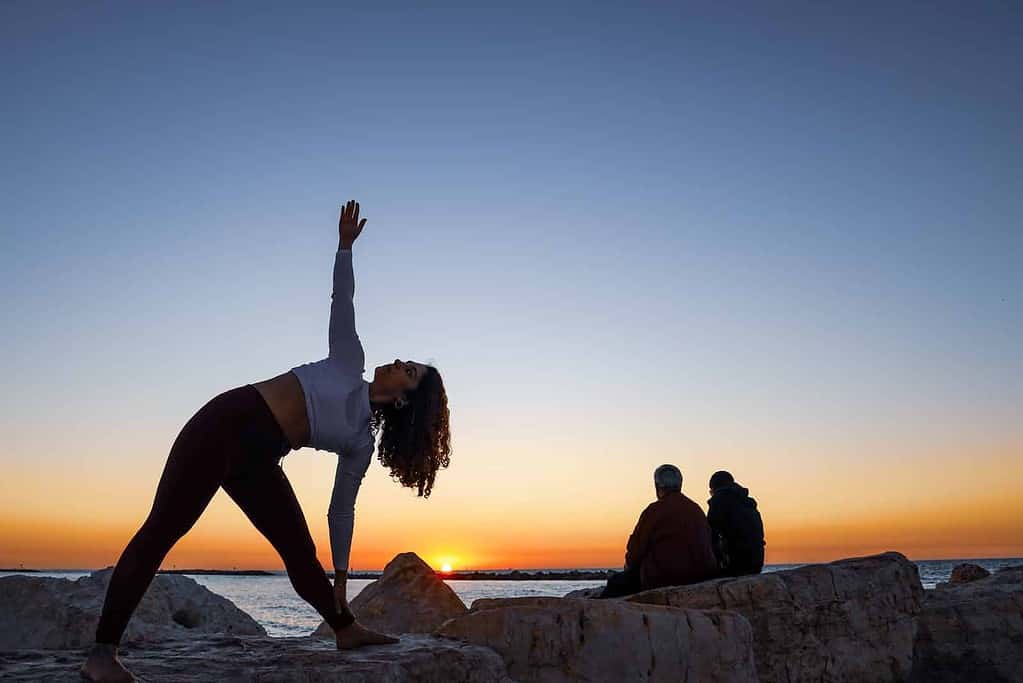
The triangle pose is a familiar beginner yoga pose. It is best done after Reverse warrior as it compresses the side body that was just stretched while elongating the other side.
Along with opening the chest and shoulders, Triangle strengthens the back, neck, and legs and stimulates the abdominal organs.
From a warrior 2 position with arms out to the side:
Straighten the front leg. Reach the front arm forward like someone is pulling it. As you do this, allow your back hip to tilt up. When you cannot extend your front arm any further, slowly lower the hand to your calf or onto a yoga block. Simultaneously reach your back hand up to the sky, pointing the fingers wide. Draw your top shoulder back to open the chest and straighten the spine. If this is difficult, move your bottom hand further up your leg. Look up to your top hand as you hold the posture.Standing Forward Bend
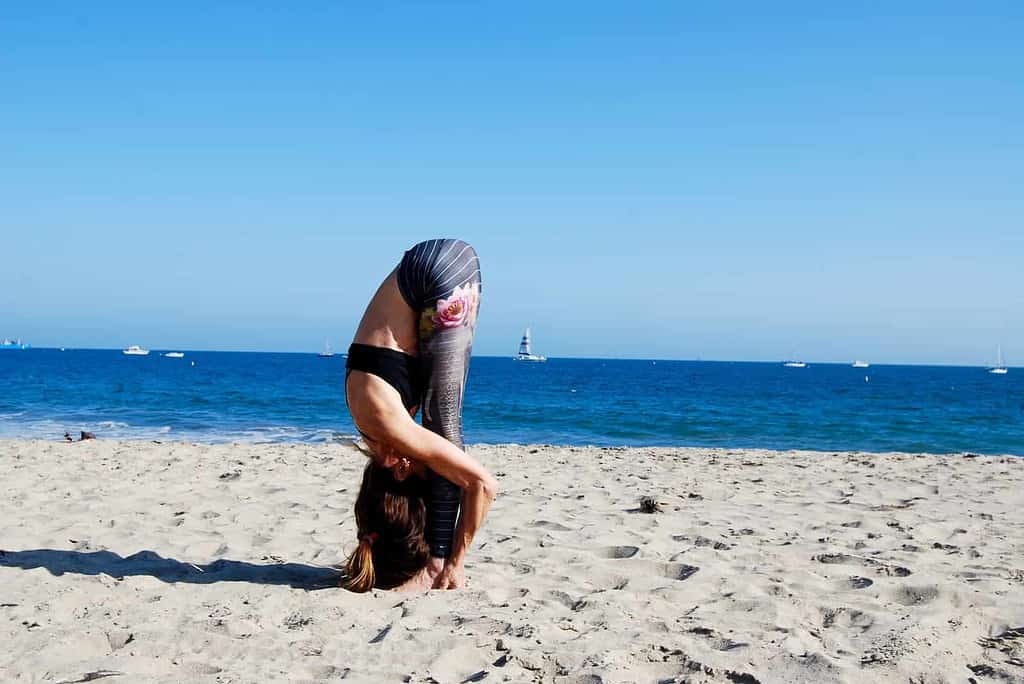
This simple forward fold is an incredibly calming pose that:
Relaxes and balances the nervous system Calms the mind and relieves headaches and fatigue Release tension from the lower back and hips. Stretches the calves and hamstrings Improves spinal mobilityFrom mountain pose:
On an inhale, reach your arms toward the ceiling and look up. On an exhale, micro bend the knees as you tilt from the hips and lower the arms and body to the ground (palms in prayer position). Let your head hang heavy with the arms and shoulder blades fully relaxed. With each exhale, try to bring your torso closer to your thighs.Tree Pose
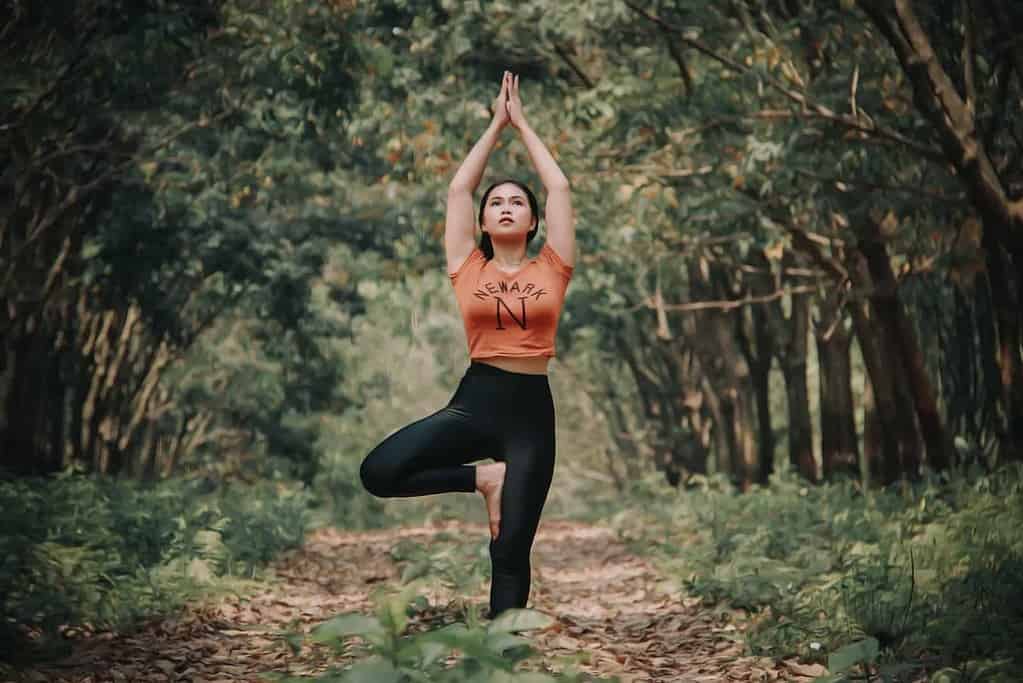
Tree pose is a standing balancing pose that improves stability, balance, and posture, strengthens the legs, and gently opens the hip. Tree pose also promotes mental clarity and focus.
Starting from Tadasana:
Shift your weight into your right foot and engage the standing leg muscles. Gently lift your left foot and turn the knee out to the side to open the hip. Either place the heel against the right ankle with the toes on the ground or press the foot against your calf or thigh. Keep rooting the standing leg down as you elongate the spine. Bring your hands into the prayer position at the heart center. Option to reach your arms overhead if your balance is good.Floor (Seated) Yoga Exercises For Beginners
Floor-based yoga poses can be practiced at the beginning of a yoga session to serve as a warm-up or after the standing poses as deeper stretches or cool-down postures.
They are generally more calming than standing postures. Still, they all have unique benefits, depending on their posture category. For example, they can be hip openers, back bends, forward folds, or twists.
Cat/Cow

Cat/cow is a popular warm-up posture that gently stretches and opens the spine while warming up the back muscles. It also opens the chest and abdomen and promotes synchronized breath movement.
Cat/cow consists of two movements that are done multiple times.
Here’s how to do it:
Start in an all-fours position on your hands and knees. Hands should be shoulder width apart from the shoulders stacked over the wrists. Knees should be hip distance apart from the hips stacked over them. Find a straight spine and on as you inhale, gently arch your spine, press your chest forwards, and look straight ahead. On an exhale, tuck the tailbone, round the spine, and bring your chin to your chest. Alternate between these movements for approximately 5 rounds. Go slowly to feel the movement of each vertebra.Child’s Pose

The Child’s pose is both a warm-up posture and a resting pose. It is often done after challenging movements and advanced poses and is held for 10 or more breaths. In these cases, the Child’s pose helps to lower the heart rate and prevents fatigue. However, it has tons of other benefits, too.
Lengthens the spine Relaxes the back muscles Stretches and opens the hips. Stretches the arms Increases blood flow to the head, which in turn, calms the mind Stimulating digestionThere are two variations of the Child’s pose; with the knees together or open. The latter gives a deeper stretch of the hips.
From an all-fours position, press your hips back toward your heels. Have the knees together or open wide, your choice. Lower the torso forward, over, or between your thighs, and walk your hands forwards, extending the arms. Rest your forehead on the floor or a block and breathe deeply, pressing the hips towards the heels.Downward Facing Dog
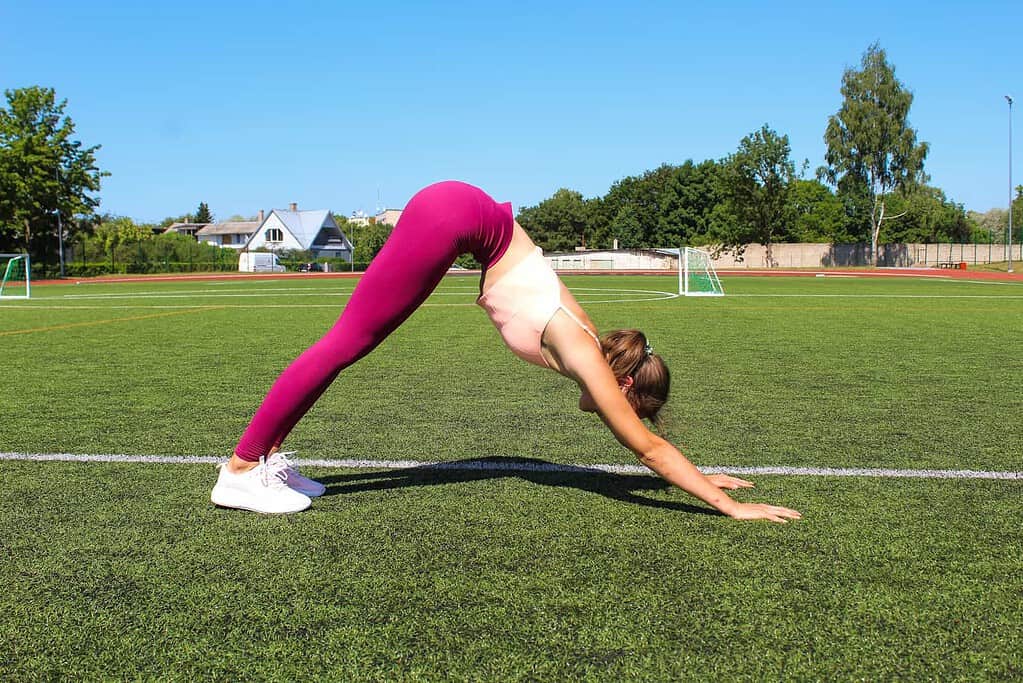
Downward-facing dog (Adho Mukha Svanasana) is one of the most famous yoga postures and is included in almost all yoga classes.
This pose strengthens and stretches the entire body, particularly the legs, arms, shoulders, and back. The downward-facing dog also improves blood circulation and relieves tension and stress.
From an all-fours position, spread your fingers wide and press your palms firmly into the mat, distributing the weight evenly. Tuck your toes and lift your knees, feeling the weight shift to your upper body. Straighten the legs as you press your hips back and up. If your hamstrings are tight, keep a slight bend in the knees. Don’t worry about bringing the soles of the feet to the floor, as this will come with practice. Keep your arms straight and gently press your chest to your thighs, maintaining a straight spine. Relax your head and gaze at your belly button.Staff Pose
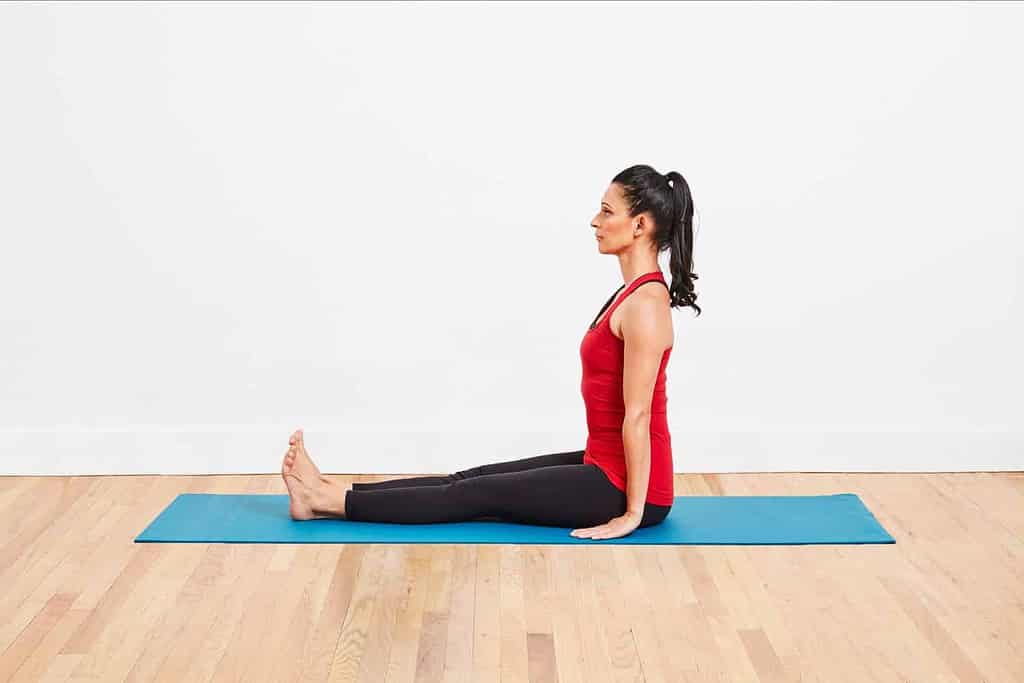
Staff pose (Dandasana) is another pose that looks simple but is quite challenging. It is excellent for improving posture, stretching the spine, and strengthening the back muscles.
Sit with both legs extended and the feet together. Many beginner yoga practitioners find it easier to sit on a block or pillow as this helps to keep the spine straight and prevents slouching. Press your sitting bones down and lengthen the spine, drawing the crown of the head up to the sky. Place your hands on the ground next to your hips and gently press into them to straighten the arms. Flex your toes towards you to engage the legs and keep them extended. Spread the toes and energetically press the thighs down.Butterfly Pose
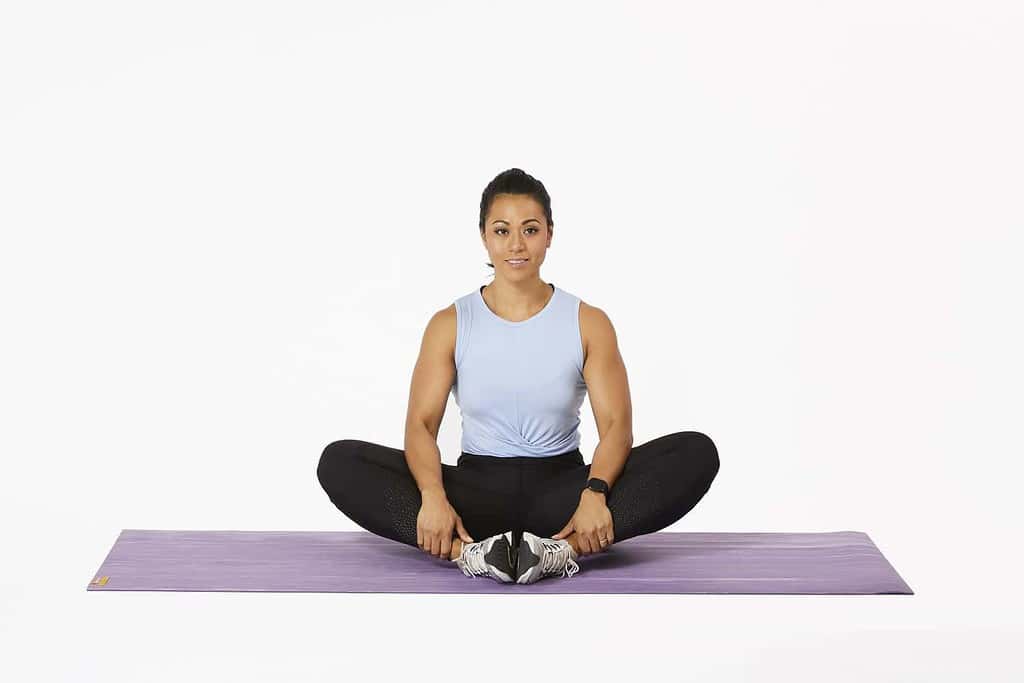
Butterfly pose (Baddha Konasana) is an excellent seated hip opener. It stretches the inner thighs, groin, and buttocks. Folding forwards in this pose also loosens the back muscles and relieves tension. In addition, this posture is very calming and can reduce stress and headaches.
From a seated position, bend your knees to the side and bring the soles of your feet to touch. Depending on the flexibility of your hips, you can pull the feet close to your body or create a diamond shape with your legs. Adjust to what feels suitable for you. I also find it helps to rock the knees up and down here a few times. With your hands on your feet or the ground, inhale to straighten the spine and then fold forwards on the exhale. If this intensifies the stretch too much, stay upright.Seated Forward Bend
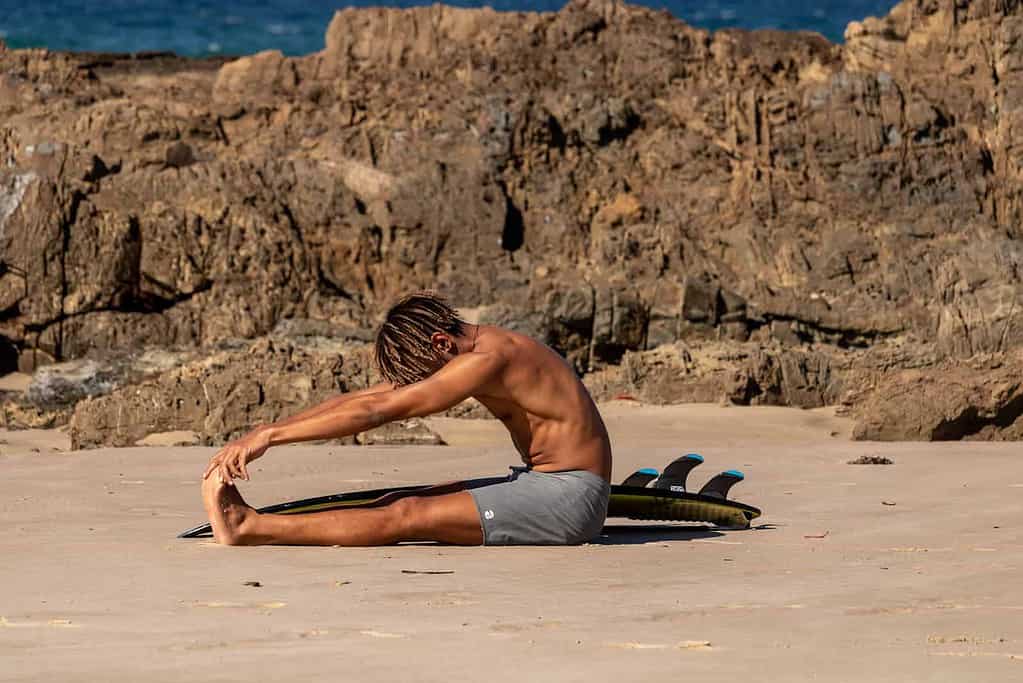
The pose stretches the hamstrings, calves, ankles, and back. It is also very calming, de-stressing, and great for relieving headaches.
From Dandasana, inhale to reach your arms overhead. As you exhale, tilt your hips as you bring your arms forward and fold over the thighs. Keep your arms in line with the ears to ensure a straight spine. Many beginner yoga practitioners make the mistake of rounding the spine to fold deeper. However, the essential thing in this pose is to keep a straight spine. Once you are at your maximum, release your hands to your legs or feet. With each exhale, try to go deeper. Bring a slight bend to the knees if your hamstrings are very tight.Seated Twist
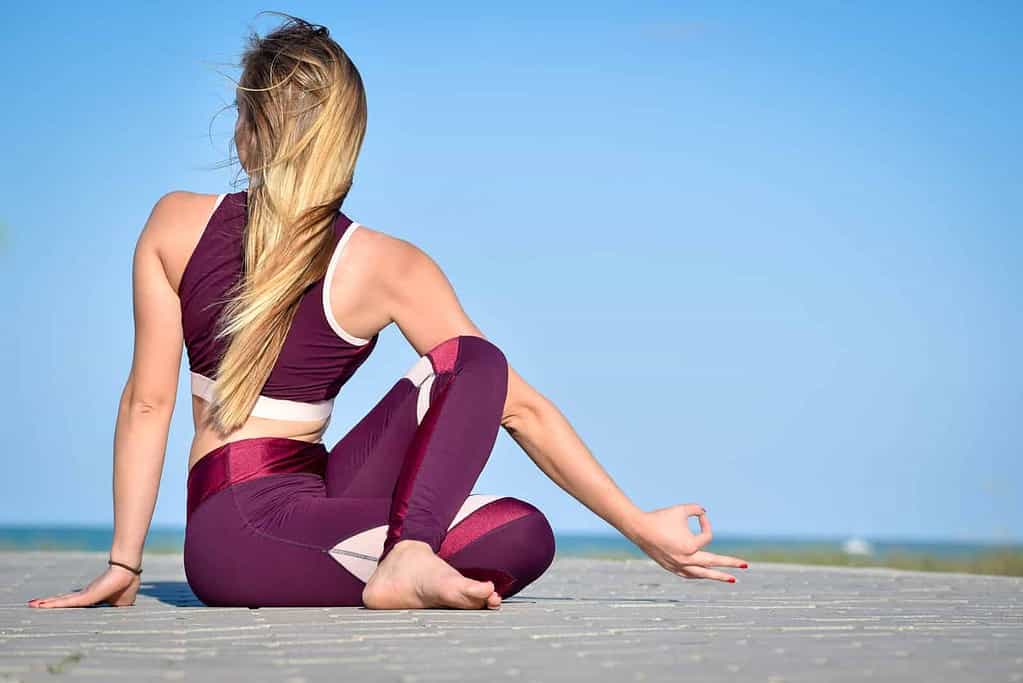
Twists are excellent for stimulating digestion and increasing spinal mobility. This seated twist (Ardha Matsyendrasana) massages the internal organs, tones the belly, and helps relieve lower back pain.
From the Staff pose, bend the right knee and place the right foot outside the left leg. Bring your right hand behind you with the fingers pressing into the ground, close to the back. As you inhale, reach your left arm up and start to twist your core to the right. Bend the left elbow and try to hook it to the outside of the right knee. With each inhale, straighten the spine, and with each exhale, twist deeper. Release slowly and repeat on the other side.Plank Pose

The plank pose is not an easy pose by any means. Still, it is an essential beginner yoga pose as it strengthens the core and upper body, helping to prepare you for more advanced poses. It is also included in the sun salutations, so it is practiced multiple times in a Hatha, Vinyasa, or Ashtanga class.
From an all-fours position, spread your fingers wide and press your palms firmly into the mat, distributing the weight evenly. Extend one leg back, tucking the toes. Shift the weight to your upper body as you extend the other leg back. Keep your shoulders over your wrists and hips in line with your body.Reclined Yoga Poses For Beginners
Reclined yoga poses are usually done at the end of the session as they help you cool down and relax the muscles. Still, like seated poses, they each have a focus, such as back bending or hip opening.
Bridge Pose

The bridge is a beginner-level back bending pose, excellent for strengthening the back muscles while stretching the torso, chest, and shoulders. It also strengthens the glutes and quads.
With knees bent, bring the feet close to your buttocks (soles on the floor). Check that you can touch your heels. Press into your feet and gently lift the hips, pressing them up to the sky. Clasp your hands behind your back and press your upper arms into the floor as you lift your hips higher. Keep the thighs activated – don’t let the knees splay to the sides.Happy Baby
Happy Baby is a gentle hip opening pose that stretches the inner thighs, hips, groin, and hamstrings and eases tension in the lower back.
Bend your knees, hugging them in towards you. Grab your big toes or the outside of the feet, then open the legs, drawing the knees to the side. Keep the knees bent and press the soles of the feet up toward the ceiling. Rock gently from side to side.Legs Up The Wall
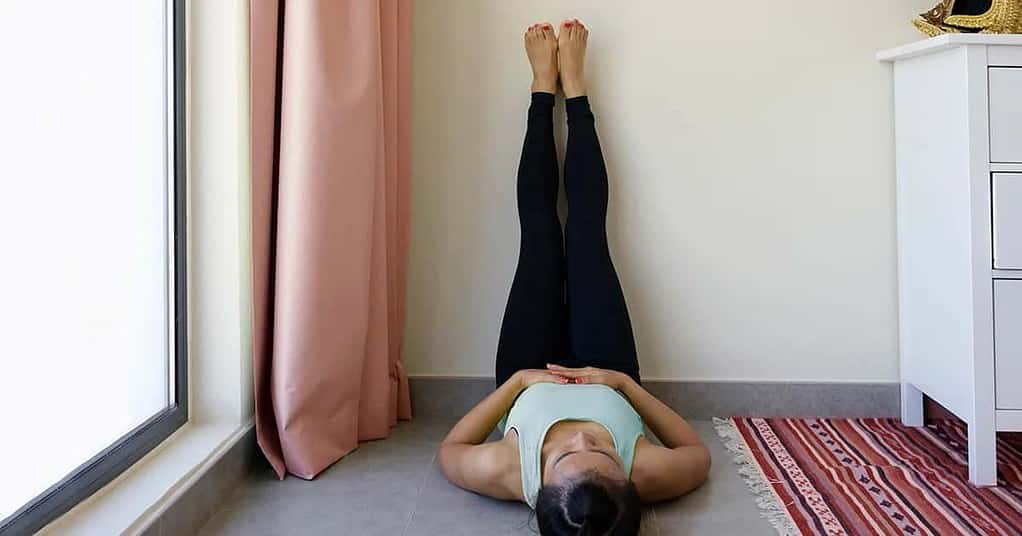
This revitalizing yoga pose is a beginner-friendly and totally safe inversion. It is self-explanatory – you lay on the floor with your legs against a wall.
However, you can also do it without a wall by placing a pillow or bolster under your hips and bringing your legs to a 90-degree angle.
This pose is relaxing, calming, and soothing for the body and mind. It improves blood circulation, helps ease tired muscles, and soothes swelling in the legs or ankles. As the position sends fresh blood flow to the brain, it also relaxes the nervous system and reduces stress.
Supine Twist
A supine twist is an ideal posture to end a yoga class as it neutralizes and lengthens the spine after all the back bending and forward folds. It also massages the abdominal organs, promotes digestion, and can ease tension from tight muscles in the back.
Hug your left knee into the chest, keeping your right leg stretched on the yoga mat. Open your left arm to the side and gently press the knee across your body to the right side using your right hand. Don’t press too much on the knee. Instead, allow the weight of the hand to assist the stretch. Gaze to your left hand and take 10 slow breaths here. Repeat on the other side, bending the right leg and extending the right arm.Corpse Pose

This is the final pose you will practice in all yoga classes. In the Corpse pose, you lay completely still on the floor (hence the name) and consciously relax your muscles.
Corpse pose (or Savasana in Sanskrit) is the most essential pose in yoga for many reasons, as it is when your mind and body integrate all the goodness from the practice.
It allows your physical body to rest. It balances the nervous system. It lowers the heart rate and can lower high blood pressure. It calms the mind and promotes presence. It promotes spiritual connection and awareness of higher consciousness.As the most restorative yoga pose, Savasana is many yogis’ favorite posture, and one everyone looks forward to.
It is also the longest pose. My teacher taught me that Corpse pose should be 5 to 10 percent of the entire yoga practice. So if you do a 60-minute yoga class, Savasana should be 3 to 6 minutes long.
Tips For Starting A Yoga Practice
Now you know the most common yoga poses for beginners, here are a few additional tips for starting an enjoyable and effective yoga practice.
Use Props
As a beginner, it’s essential not to push yourself too far, as doing so can easily cause injury. Thankfully, a range of yoga props will help support your body in your practice. Here are three essential yoga accessories I recommend:
Yoga Block
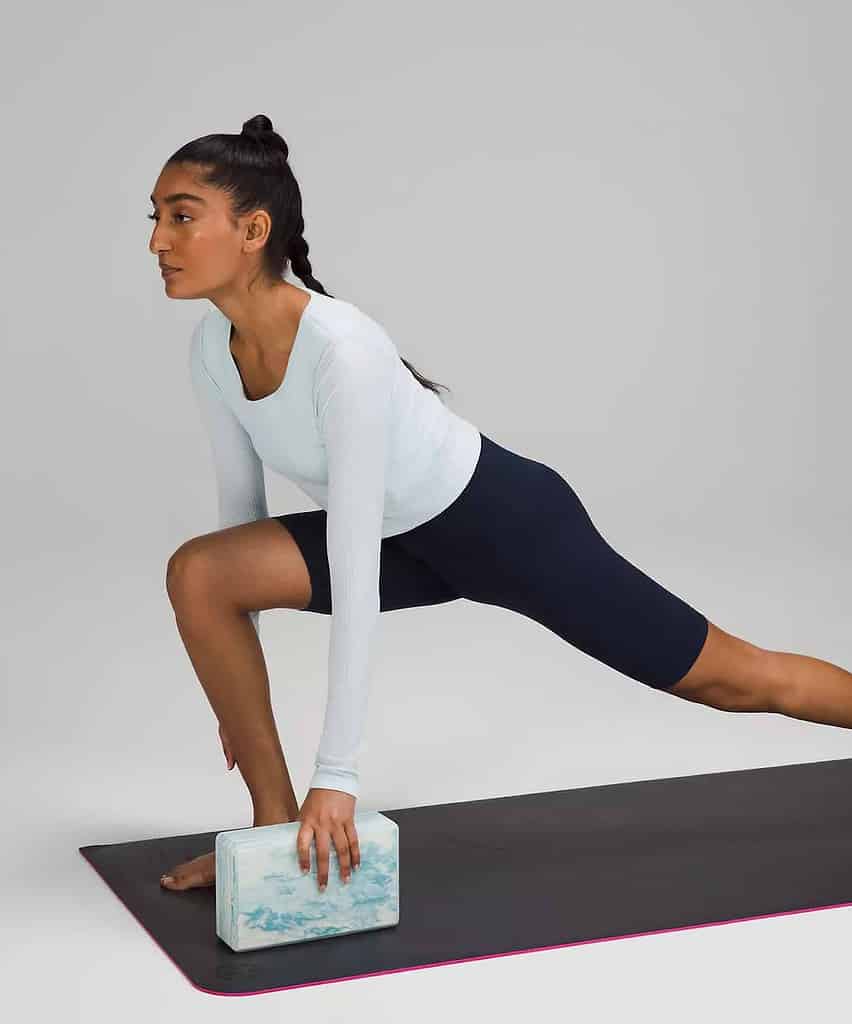
A block is handy for many poses, such as the Triangle pose, Bridge pose, and Standing Forward bend. It can assist you when you’re experiencing a lack of flexibility, give you more stability in balancing poses and make asanas more restorative.
Yoga blocks have three height levels you can use depending on your needs. I use the Lululemon Lift and Lengthen Yoga Block as it is made from comfortable yet durable dense foam and is super lightweight.
Bolsters are excellent for restorative yoga and can turn active stretches into supportive, passive ones. For example, you can place it between your thighs in a wide-leg child’s pose or under your knees in Savasana.
I like the Gaiam Rectangular Bolster as it also doubles up as a pillow in seated positions. It is filled with natural cotton batting for maximum comfort and support.
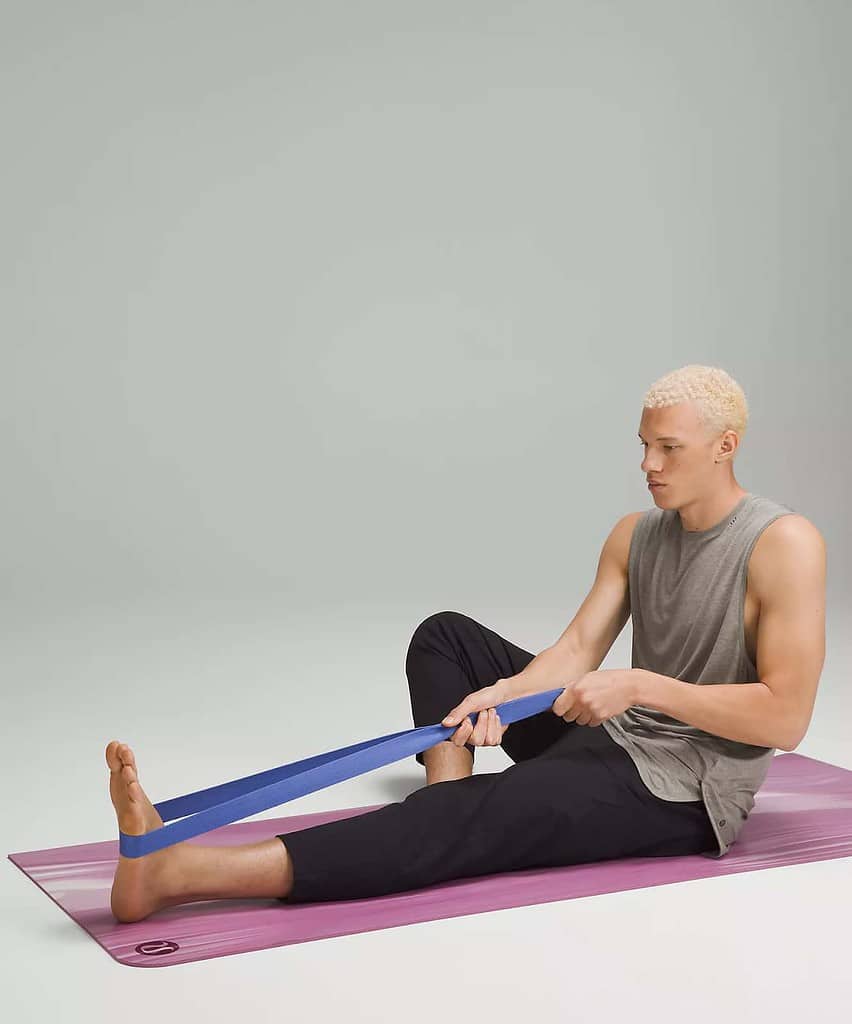
There are many uses for a strap in a yoga class, but one of the most common for beginners is seated forward bends. If you can’t reach your feet, place a belt around the soles and use it to gently lower your torso to your thighs.
As well as being easy to adjust, yoga straps allow you to create a loop, like the Lululemon No Limits Strap. This gives additional support, such as protecting the knees in the Butterfly pose.
Learn The Proper Alignment
While learning yoga at home is fine, I suggest seeking a certified yoga instructor for at least a few in-person or online yoga classes.
I personally love the energy in a group yoga class, but private sessions are best when first starting out. In a private lesson, the yoga teacher can break down the alignment and correct where you go wrong.
A yoga mat with an alignment system, like this one from Liforme, is an excellent idea for learning alignment in standing poses. The innovative ‘AlignForMe’ design helps you find the correct foot placement. It’s also one of the most durable and eco-friendly mats around!
Don’t Overdo It
Finally, when beginning any new exercise or movement practice, it’s vital to ease yourself into it. Even if you fall in love with yoga from the get-go, I recommend initially practicing about 3 to 4 times a week.
This is important to prevent muscle fatigue and injury. But don’t worry; once you’ve practiced for a while, you can practice yoga daily!
Also, remember to do all poses on both sides, so you don’t create an imbalance and overwork muscles on one side.
Final Thoughts On Yoga Poses For Beginners
You don’t have to be flexible to start a yoga practice. Practicing yoga will help you increase your flexibility and mobility while boosting your health and well-being in more ways than you can imagine.
Start with these 20 yoga exercises for beginners. Before you know it, you’ll notice a massive difference in your body and mind!

 Troov
Troov 








